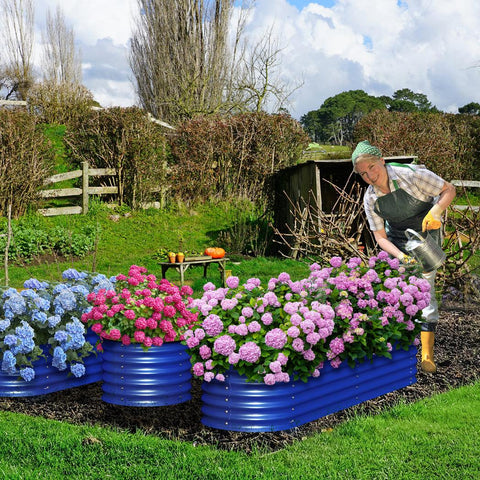How Long Should You Drip A Raised Garden Bed
One of the lessons I learned after installing the drip irrigation system for the first time was how easy it was to over water and under water plants in a raised garden bed. The key to proper watering is to arrange the time correctly.
You should drip a raised garden every other day for 15 to 45 minutes, providing approximately 1 inch of water per week, depending on the season, soil type, bed size, and number of emitters on the drip line. Flow, plant size, and mulch also affect watering time.
The response of the plant will guide you whether to let the dropper run longer or shorten the time and frequency. I will discuss the factors that affect your decision when raising garden beds with drip irrigation.

How long does the drip irrigation run on the raised garden bed
Raised garden beds are different from underground gardens. They have limited or no soil compaction, better drainage and longer growing seasons. They also have different watering requirements.
When you use a watering can or garden hose, you can know how much water your plant gets. Drip irrigation of a raised garden makes it easy for you to water plants underwater or over water them, because you cannot estimate the amount of water released.
How long the drip irrigation system runs on the raised garden bed depends on the following factors.
Size and type of raised garden bed
The size of the raised garden bed and the space of the drip line will determine how long you water the raised garden. 1/2 inch (1.27 cm) and 1/4 inch (0.63 cm) drip pipes are the most common in raised gardens.
A 1/4-inch (0.63cm) tube is best for small gardens, while a 1/2-inch (1.27cm) tube is ideal for large raised garden beds.
A 1/2-inch (1.27cm) drip can release up to 200GPH (gallons per hour), while a 1/4-inch (0.63cm) drip can release up to 30GPH. If you use a smaller production line on a large raised garden bed, it will take longer to run than using a 1/2-inch tube.
It is important to note that 1/4-inch pipes should not be used in gardens that require more than 17 feet (5.2m) of pipe. In this case, a 1/2-inch tube is ideal.
Raised garden beds without frames lose water as runoff or evaporation occurs. Therefore, you may need to run the drip irrigation system longer than the bed with frame.
Season
In summer, you need to run the drip tube longer than in the cool season, because water evaporates faster in hot weather. When it is windy and dry, you also need to water the plants a little more.
Plants lose some of the water in the soil by evaporation. They also lose some of the water they absorb through transpiration.
In the colder months, the soil retains water for a longer time and the evapotranspiration rate is lower. If you keep your summer watering schedule in autumn and spring, you may have wet soil.
Number of transmitters
In line transmitters with 1/2 inch (1.27 cm) tubes are spaced 9 – 12 inches (22.86 cm – 30.48 cm) apart, while transmitters with 1/4 inch (0.63 cm) tubes are spaced 6 – 12 inches (15.24 cm – 30.48 cm) apart.

The spacing between emitters is affected by the following factors:;
- Type of soil.
- Plant thirst.
- The soil is exposed to sunlight.
- Well drained soil absorbs water more quickly, so the space between emitters should be wider than the space between drip lines in a raised garden with dense soil.
- A factory with multiple transmitters will not need to run the line for as long as a factory with one transmitter. If you have thirsty plants, you'd better have more emitters on the drip line.
The types of plants in the garden
Plants in the raised garden play a crucial role in determining the duration of your drip line. Plants have different water requirements. For example, tomatoes have deep roots and need more water than green leafy vegetables.
As far as possible, plants with similar watering needs should be planted together in a raised garden bed. If this is not possible, you need to find a balance when watering plants with different water needs.
Wet plants: tomatoes, eggplants, basil, carrots, coriander, celery
Plants that need little water: herbs (rosemary, sage, marjoram), green leafy vegetables, peppers, French beans, vegetables
If your raised garden bed has plants with high and low water requirements, you should consider covering to reduce water loss. You should also set the timer to a duration that will not harm the plant.
Factory size
New plants may not be watered as long as established plants, but more frequently. Older plants will benefit more from deep but infrequent watering.
Most plants have roots 6 – 12 inches (15.24 cm – 30.48 cm) deep in the soil of the raised garden. These plants need at least one inch (2.54 cm) of water a week. Deeper roots may require more water.
New plants usually need more water because some of it is lost through evaporation. As they grow taller, the leaves protect the soil from the sun, so most of the water stays underground.
If the raised garden bed is wet, you will run the drip pipe for a short time. However, when the weather is hot, mature plants will lose more water through transpiration, so you need to water them for a longer time.

Conclusion
There is no standard watering time for drip irrigation of raised garden beds. To avoid over watering or under watering, check the raised garden bed to see how wet or dry it is before setting the timer.
If the soil is slightly damp, water the plants for a short time. Also, if the soil is dry, run the drip line longer.
